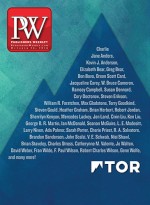Though some people consider the threat of climate change to be up for debate—this year especially, as it’s become a major, divisive campaign issue this election season—there’s no denying its influence on speculative fiction. Critical and commercial successes of recent years include books by Paolo Bacigalupi (2009’s The Windup Girl and 2010’s Ship Breaker, among others) and Margaret Atwood (the trilogy that concluded with 2013’s MaddAddam), and the coming months bring a flood of titles that place environmental concerns front and center.
“The fear of climate-related disaster, particularly disaster in which humankind has played a terrible role, is prevalent right now—as is a desire to amend it,” says Rene Sears, editorial director at Pyr, which is publishing Wilders by Brenda Cooper in June 2017. The book launches a duology set in a future megacity called Seacouver, at a time when the planet’s wilderness has been devastated due, in part, to climate change.
The following month, in Carrie Vaughn’s Bannerless (HMH/Adams), widespread environmental and economic collapse has led a community in what used to be the United States to institute strict population-control measures, requiring couples to earn the right to raise children. Bannerless takes climate change as a given and imagines how humanity, or some of it, might survive.
A sense of hope, however small, persists amid many bleak scenarios. In Walkaway by Cory Doctorow (Tor, Apr. 2017), climate change has destroyed much of the world, and a handful of cities control all of the wealth. Tor’s associate publisher, Patrick Nielsen Hayden, says that despite the premise, this is not an apocalyptic book.
Walkaway has “lots of conflict, lots of change, but no apocalypse—just an uncertain future,” Hayden says.
A November title from Tor.com, The Burning Light by Bradley P. Beaulieu and Rob Ziegler, takes place in a world devastated by climate change. The imprint’s Justin Landon, who edited the novella, says that authors such as Beaulieu and Ziegler are positioning catastrophic events not as the end of everything but as a beginning: “The new trend I’m seeing is books that say, ‘Okay, but then what?’ ” These works begin, he says, with the assumption that we failed to save our world, and from there ask, how can we change ourselves to survive?
The Chosen Ones
In many apocalyptic scenarios, it’s not just a question of how to survive, but who survives. David Williams’s When the English Fall (Algonquin, July 2017) imagines who might best navigate a radical change.
In the novel, a solar storm, which the narrator suggests may be related to global changes in weather patterns and the environment on Earth, destroys modern civilization. A self-sufficient Amish community weathers the storm and finds itself set upon by desperate outsiders unable to cope with the loss of their comforts and technology.
Several books ask readers to consider whether we’re being complicit in our own destruction. Anne Corlett’s debut novel, The Space Between the Stars (Berkley, June 2017), opens with the lead character’s realization that she is one of the few survivors of a super virus that has wiped out much of Earth’s population. The book’s editor, Cindy Hwang, says Corlett asks whether the individual or society as a whole should shoulder the blame: “The characters in the book struggle with whether we deserve to survive as a species—if humans have both directly and indirectly contributed to the destruction of our world.”
How humanity might end life as we know it—and, possibly, rebuild afterward—figures in many forthcoming titles. Here’s a look at some others.
The Final Day
William Forstchen. Forge, Jan. 2017.
Forstchen (who has coauthored several books with Newt Gingrich, including the alternative history 1945) launched his One Second After series in 2009 with the novel of the same name, in which an electromagnetic pulse of unknown origin knocks out nearly every electrical device on the planet. In this third installment, the U.S. continues to rebuild after the havoc that followed. One Second After and its sequel, One Year After, have together sold 397,000 print copies, per Nielsen BookScan.
New York 2140
Kim Stanley Robinson. Orbit, Mar. 2017
Setting his latest novel after a 50-foot global sea-level rise, Robinson, who frequently addresses environmental themes in his fiction, here shows how humanity might move forward after catastrophe—New York City is still a vibrant metropolis, one in which the streets are canals and skyscrapers are islands. The Hugo, Nebula, and Locus award–winning author’s previous works include 2312 (Orbit, 2012; 81,000 print copies sold, per BookScan), which PW’s starred review praised as “a magnificently realized, meticulously detailed future in which social and biological changes keep pace with technological developments.”
NK3
Michael Tolkin. Atlantic Monthly, Feb. 2017
After the release of a man-made neurological agent that destroys memory, society is divided into the haves (those with memory) and have-nots (those without). In Los Angeles, a 60-foot-tall fence encloses the haves in the mansions of the former Hollywood elite, while the have-nots—the mindless and nameless Drifters, Shamblers, and Bottle Bangers—remain outside. The devastation also serves as a commentary on the power of celebrity culture: Tolkin is the author of Hollywood satire The Player (1988) and wrote the Edgar Award–winning screenplay for the 1992 film adaptation, directed by Robert Altman.



 Volume 263
Issue 43
10/24/2016
Volume 263
Issue 43
10/24/2016





